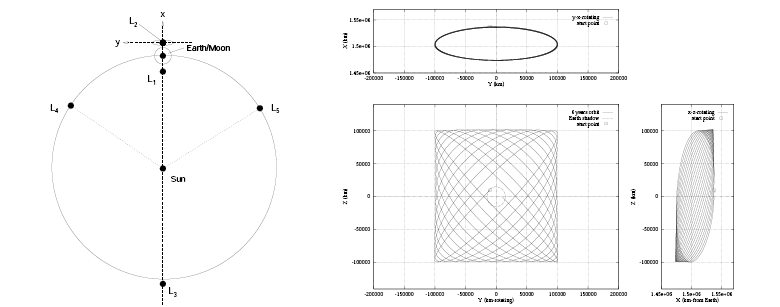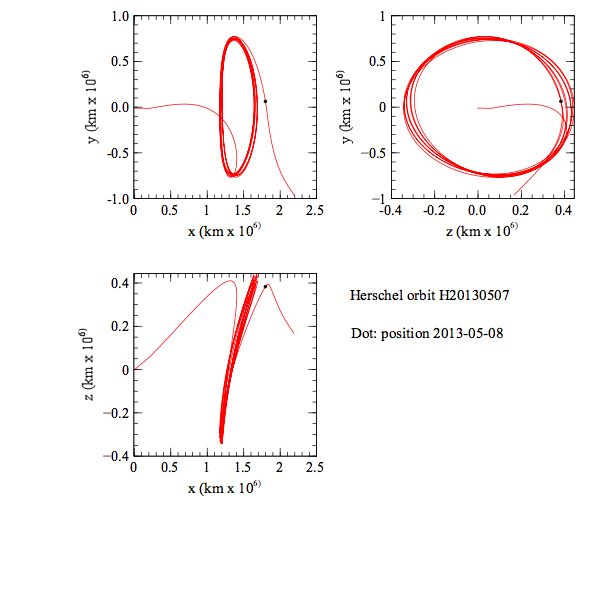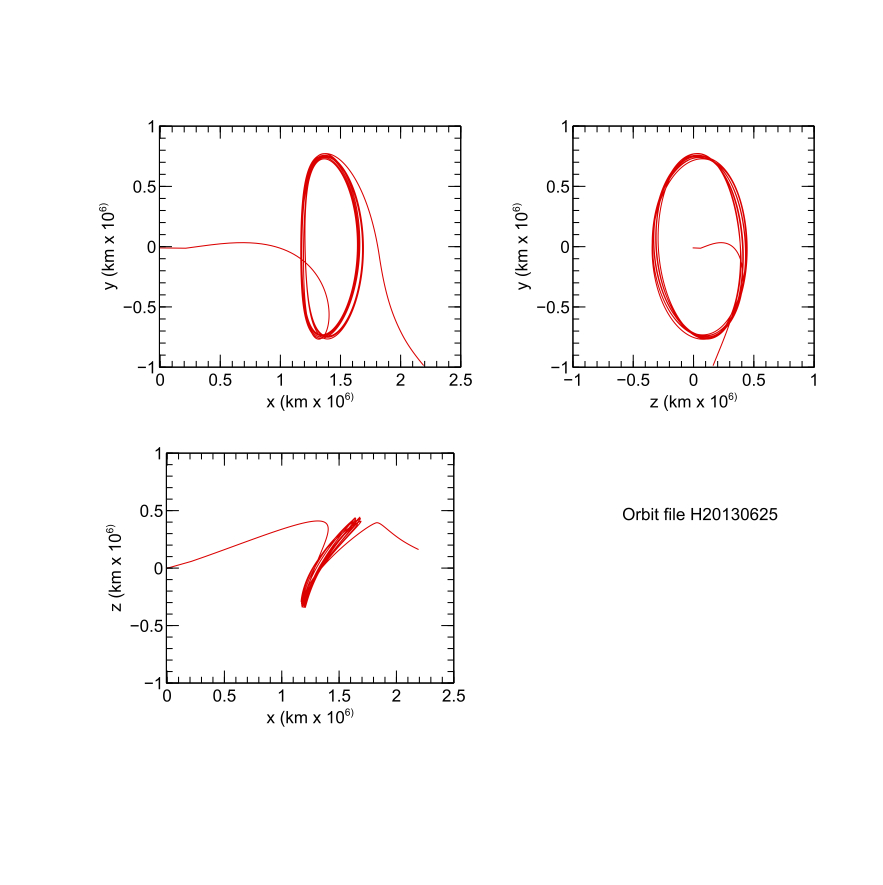Herschel and Planck were launched aboard an Ariane 5-ECA launch vehicle from European spaceport at Kourou. The launch made use of the Sylda 5 adapter, with Planck being the lower passenger below the Sylda 5 and Herschel mounted as upper passenger. The two spacecraft separated within 30 minutes after launch and proceeded independently to different orbits about the second Lagrange point of the Sun-Earth system (L2) (see Figure 2.6).

Figure 2.6. Left:The position of the Lagrange points for the Sun-Earth/Moon system. L2 lies 1.5 million kilometres from Earth. Right: An example of a Lissajous orbit around L2. The orbit x and y-axis are as shown in the plot on the left, the z-axis is normal to paper.
Even though both satellites orbited around L2, their orbits were quite different: while Herschel went into a large, loose orbit that did not require an injection burn, Planck required a braking burn to go into its smaller and tighter orbit around L2. Herschel acquired its final orbital position at around 1.5 million km from the Earth after a transfer of about sixty days, with only a minor initial correction manoeuvre required early in cruise phase.

Figure 2.7. A representation of Herschel's orbit around L2 from top, side and front perspectives (i.e. seen along the z, y and x axes). The Earth is located at (0,0,0) in each plot. The red tracks are the projection on the three orthogonal planes of the 3D orbit from launch through to the end of June 2013, showing its position (blue dot) on May 8th 2013, nine days after End of Helium, already moving away from L2 as a result of the initial escape manoeuvre, which can be identified as a kink in the track, particularly in the perspective from above (top left), above the Earth's orbital plane. The horizontal and vertical axis scales are different, thus the orbit's shape is severely distorted in this view, although details of the individual loops around L2 are better visible than in an equal axis plot. A plot with the two axes on an identical scale to remove this distorion is shown in Figure 2.8. Plot generated by Jon Brumfitt based in the orbit file generated by the Flight Dynamics Team at MOC.
The Herschel spacecraft was eventually placed in a large "halo" orbit around L2 (halo orbits are special cases of Lissajous orbits around Lagrange points where the in-plane and out-of-plane frequencies are the same), with an amplitude of about 700 000km and a period of approximately 178 days. The distance from the Earth ranged from 1.2 to 1.8 million km.
The orbit chosen for Herschel presented a number of advantages summarised below:
It simplified long observations, since the Sun and the Earth remained close to each other as seen by the S/C (Sun-S/C-Earth angle was always < 40°)
It gave a very stable thermal and radiation environment
There was no trace of atmosphere
The environment at L2 is clear of space debris
A large halo orbit can be achieved without an injection Δv
Major drawbacks were the long distance for communications, requiring a 35-m class antenna and the fact that orbits around the L2 are unstable; without orbit corrections the spacecraft would have deviated exponentially from the nominal one. Small correction manoeuvres, applied at approximately monthly intervals, maintained the orbit close to the nominal one. Figure 2.7 shows the actual Herschel halo orbit around L2.

Figure 2.8. Herschel's orbit from launch to the end of June 2013, as for Figure 2.7 plotted with equal axis scales to give a more faithful representation of the orbit shape, at the cost of some loss of fine detail. The rapidity of the satellite's drift away from L2 after the disposal burn is manifest in this image. Plot generated by Jon Brumfitt based in the orbit file generated by the Flight Dynamics Team at MOC.
Herschel operations were performed by the European Space Operations Centre (ESOC) located in Darmstadt (Germany). The main ground station was New Norcia (Australia), which is equipped with a a 35-metre antenna using X band up and down links. New Norcia was backed up by the Cebreros ground station (Spain). In the phase immediately after launch the Kourou (French Guiana) was also used. During routine operations, the ground station communication link was restricted to a duration of approximately 3 hours. During this time, the spacecraft antenna was pointed to the Earth. The data stored in the on-board solid state mass memory were downlinked, and the mission time line with the new schedule was uplinked. Real time operations and spacecraft maintenance were also carried out during this period. The rest of the time the satellite operated autonomously. The system was designed to support 48 hours of autonomous operation, with required a solid state mass memory capability of 25 Gbt. The amount of Herschel data downloaded per day was in excess of 8 Gbt.